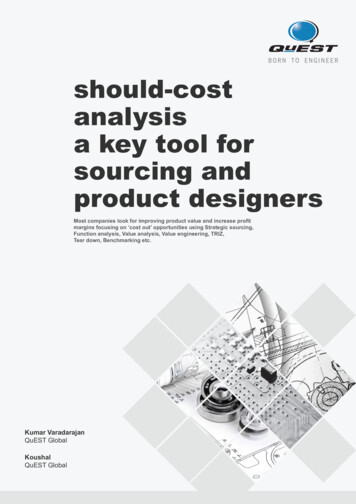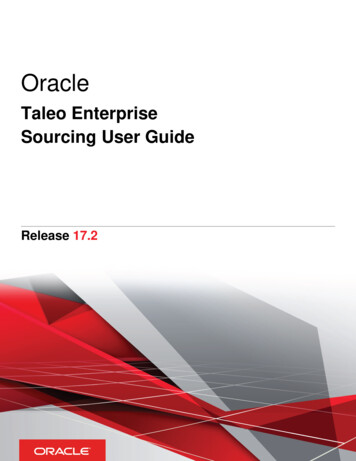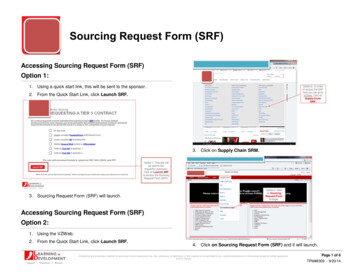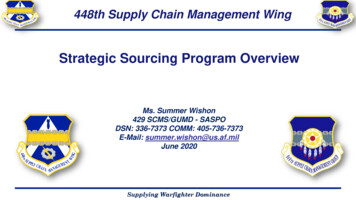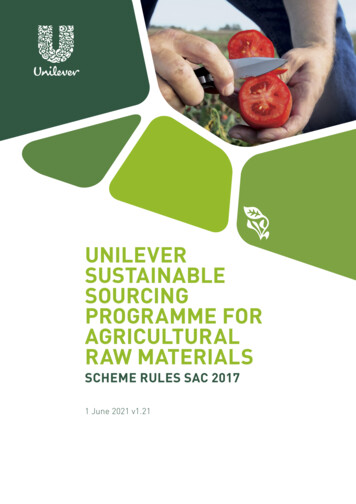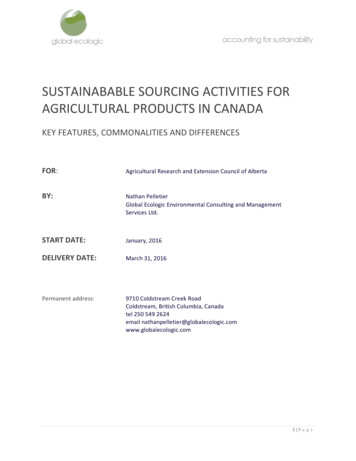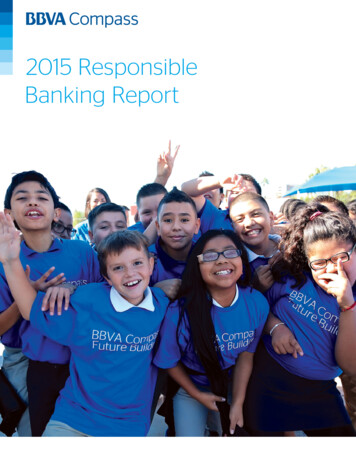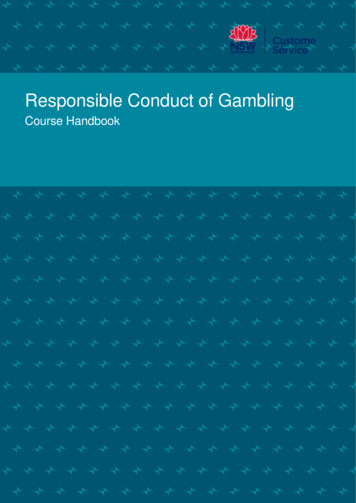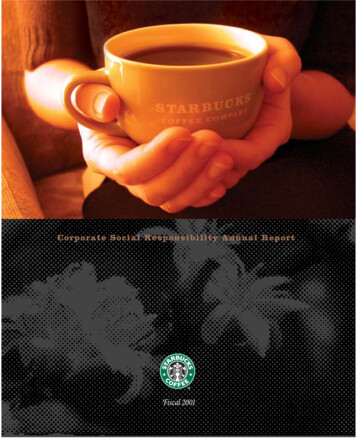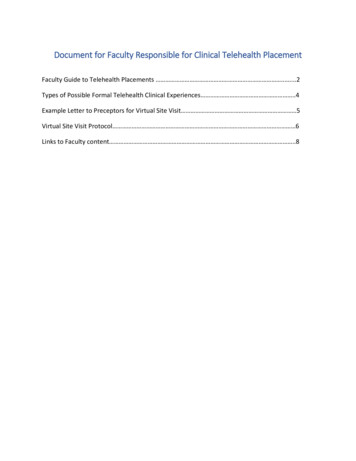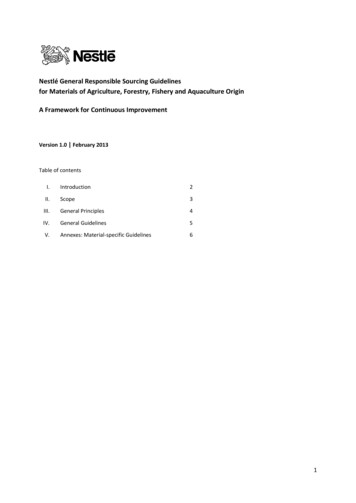
Transcription
Nestlé General Responsible Sourcing Guidelinesfor Materials of Agriculture, Forestry, Fishery and Aquaculture OriginA Framework for Continuous ImprovementVersion 1.0 February 2013Table of contentsI.Introduction2II.Scope3III.General Principles4IV.General Guidelines5V.Annexes: Material-specific Guidelines61
I. IntroductionThis document presents Nestlé’s General Responsible Sourcing Guidelines (RSGs) for materials of agriculture,forestry, fisheries and aquaculture origin (the so-called “soft commodities”).The General RSGs establish a framework for Nestlé’s engagement with suppliers with the long-term ambition thatall materials of agriculture, forestry, fishery and aquaculture origin the company purchases will come from legallycompliant and responsible sources that are committed to a process of continuous improvement towards1environmental, economic and social sustainability, based on supply chain transparency and credible verification.Nestlé’s worldwide raw and packaging material supply chains are characterised by a high degree of diversity interms of locally prevailing production systems, scales of production (ranging from smallholders to large-scaleproducers), cultures, consumer preferences, climates and ecological variables. Nestlé purchases a range of rawmaterials directly from more than 600’000 farmers globally. At the same time, many other Nestlé supply chainsare long and complex and involve a wide range of different actors, including agricultural input providers, farmers,primary and secondary processors, carriers, traders and middlemen. Nestlé acknowledges the importance ofapplying a long-term approach to driving transparency and continuous improvement against our RSGs in ourupstream value chains back to the origin. To this end, RSG Action Plans are being put in place for major raw andpackaging material supply chains, comprising short-, mid- and long-term activities in line with the overall concept:“remove the worst, promote the best, improve the rest”. The RSGs and Action Plans form an integral part ofNestlé’s supplier selection, evaluation and development process. Nestlé will report publically on annual basis onthe progress achieved in implementing the RSGs.The RSGs complement the Nestlé Supplier Code and are applicable to all stages of the upstream value chain backto the primary production level. They are intended to be complemented with specific guidelines and practicaltools adapted to local or regional conditions in compliance with national laws and regulations. The RSGs will beregularly revised, as appropriate, based on an evaluation of their practical workability and effectiveness inmeeting sustainability objectives.The RSGs have been produced to guide Nestlé Businesses in the design and implementation of ResponsibleSourcing Action Plans for specific raw and packaging materials and to support Nestlé Procurement andAgricultural Services in the assessment and continuous development of Nestlé suppliers against our corporatecommitments and responsible sourcing requirements, as follows: Nestlé Corporate Business Principles Nestlé Supplier Code Nestlé Policy on Environmental Sustainability Nestlé Commitment on Climate Change Nestlé Commitment on Deforestation and Forest Stewardship Nestlé Responsible Sourcing Guidelines: Framework for Forest-based Materials Nestlé Responsible Sourcing Guidelines: Specific Requirements for Water Use in Agriculture Nestlé Commitment on Child Labour in Agricultural Supply Chains Nestlé Commitment on Rural Development Nestlé Commitment on Farm Animal Welfare United Nations Universal Declaration on Human Rights ILO Declaration on Fundamental Principles and Rights at Work (1988) United Nations Global Compact Principles1Throughout these RSG the term “sustainable” encompasses all three dimensions: environmental, social and economic.2
The General RSGs comprise three sections:1.General Principles driving the overall concept “remove the worst, promote the best, improve the rest”2.General Guidelines applicable horizontally to all materials of agricultural, forestry, fishery andaquaculture origin3.Annexes: Material-specific Guidelines that complement the General Principles and Guidelines by definingpriority areas for continuous improvement for the material in questionII.ScopeThe General Principles and Guidelines apply globally to all Nestlé purchases of raw and packaging materials ofagriculture, forestry, fisheries and aquaculture origin.The commodity-specific Guidelines apply globally to the material in question.All Guidelines are applicable to all stages of the upstream value chain back to the primary production level.3
III. General PrinciplesIn engaging with its suppliers, Nestlé will apply the following principles that are driving the overall concept“remove the worst, promote the best, improve the rest”.a)Continuous improvementNestlé is committed to continuously and sustainably increasing the share of raw and packaging material sourcedin compliance with the RSGs. All Nestlé suppliers are expected to engage in a process of continuous improvementand to verify their processes and practices against the RSGs. The RSGs form an integral part of Nestlé’s supplierassessment, selection and development process.b) Transparency along the value chainNestlé expects its suppliers to conduct their business with Nestlé in an open and transparent way, which includesproviding transparency of material flows throughout the entire upstream value chain and the provision of accurateinformation on all aspects covered by the RSGs.c)Supplier accountability and supplier supportNestlé expects its suppliers to take ownership and leadership in developing and implementing continuousimprovement measures against all aspects of the RSGs. As appropriate, Nestlé will provide support to suppliers thatare not yet able to comply with all aspects of the RSGs, but are committed to becoming compliant over time anddemonstrate continuous and tangible progress.d) Credible verificationNestlé’s direct (tier 1) suppliers are audited by independent third parties against the minimum requirements ofthe Nestlé Supplier Code. These audits form part of Nestlé’s Vendor Approval Process.In its extended value chains, Nestlé is committed to applying a consistent process of monitoring and verification ofsuppliers’ performance and continuous improvement against the RSGs. In the case of high sustainability risks, thisprocess may be complemented by independent on-site audits or certification against effective and crediblestandards for sustainable agriculture, forestry, fisheries and aquaculture.e) Shared value for rural communitiesNestlé recognizes the important socio-economic contribution of the agriculture, forestry, fishery and aquaculturesectors to the livelihoods of local communities, including smallholders in developing countries. Nestlé strives tocooperate with supply chain partners and stakeholders to support the long-term economic and social viability ofproduction systems that contribute to sustainable local and rural development. Small producers shall not facedisproportionate barriers to becoming a Nestlé supplier as a consequence of the implementation of the RSGs.f)Stakeholder engagementBeyond Nestlé’s work in its own supply chains, Nestlé is committed to engaging with business partners, publicpolicy makers, local authorities, international organisations, civil society organisations, and other relevantstakeholders to contribute to a process of continuous sustainability improvement in the agriculture, forestry,fishery and aquaculture sectors.g)Reporting and communicationNestlé is committed to transparently communicating on its progress made in implementing the RSGs to its supplychain partners and other relevant stakeholders. Nestlé will provide regular updates on its corporate website andin the annual Nestlé in Society Report.4
IV. General Guidelines1. Compliance2a. Suppliers comply with all applicable laws and regulations.b. All materials and products supplied to Nestlé have been produced in compliance with The Nestlé CorporateBusiness Principles and the Nestlé Supplier Code.2. Economic sustainabilitya. All materials and products delivered by suppliers meet the quality and safety standards required byapplicable law and by Nestlé safety and quality requirements.b. The long-term financial stability of the production system is pursued in line with market characteristics toenable proper investments and, as applicable, workforce payments.c. There is transparency of material flows throughout the entire upstream value chain to promote marketaccess for safe, high quality products that have been produced in a responsible way.d. Market information is available to producers.3. Human Rights & Labour Practicesa. Suppliers respect all applicable human rights.b. Labour practices:i. There is no use of forced or compulsory labour.3ii. There is no use of child labour. Child labour refers to work that is mentally, physically, socially, morally4dangerous or harmful to children or that improperly interferes with schooling needs.iii. The rights of workers to freedom of association and collective bargaining are respected, consistent with5applicable ILO Conventions.iv. Workers’ wages and benefits comply with minimum legal requirements or mandatory industrystandards, including any applicable binding collective agreements.v. Employees work in compliance with all applicable laws and mandatory industry standards pertaining tothe number of hours and days worked.vi. Workers are provided with a safe and healthy workplace, including, as applicable, safe housingconditions. As a minimum, potable drinking water, adequate sanitation, emergency exits, essentialsafety equipment and access to emergency medical care are provided.vii. Hiring and employment practices do not discriminate on the ground of criteria such as race, colour,religion, sex, age, physical ability, maternity, religion, ethnicity, physical conditions or political views.2Throughout the RSGs, the term “supplier” includes all sub-suppliers back to the primary production stage.ILO Conventions 29 and 1054Nestlé Supplier Code, ILO Conventions 138 and 1825ILO Convention 87 and 9835
4. Environmental sustainability:a. There is no sourcing from areas converted from natural forests6after 1 February 2013.7b. High Conservation Values (HCVs) are identified and effectively maintained and/or enhanced.8c. Suppliers identify and reduce their significant environmental impacts in a process of continuousimprovement, which includes, as applicable, the following aspects:i. Water withdrawal from the environment is minimized and water pollution is preventedii. Waste is prevented, reused, recycled, recovered and disposed of in an environmentally sustainable wayiii. Soil quality and soil fertility are maintained and/or enhancediv. Biodiversity is maintained and/or enhancedv. Greenhouse gas emissions are mitigatedvi. Air emissions from processing plants are mitigatedvii. Energy is used efficiently5. Local communities and rural development:a. Suppliers can demonstrate legal entitlement to land ownership or other pertinent land use rights.b. Agricultural and forestry development on local peoples’ land is subject to the free, prior and informed9consent of the affected local communities, including indigenous peoples.c. Farming, forestry, fishing and aquaculture activities contribute to rural development.6. Animal welfare:Animal welfare practices along the upstream value chain are guided by the General Principles for the Welfare10of Animals in Livestock Production Systems developed by the World Organisation for Animal Welfare (OIE) ,to be implemented in a process of continuous improvement. A science-based approach is applied to definingcriteria and indicators to evaluating farm animal welfare on the basis of the “Five Freedoms” 1) freedom fromhunger, thirst and malnutrition; 2) freedom from fear and distress; 3) freedom from physical and thermaldiscomfort; 4) freedom from pain, injury and disease; and 5) freedom to express normal patterns of behaviourof farmed animals.6Nestlé Responsible Sourcing Guidelines: Requirements for forest-based materials: als%20October%202012.pdf7Earlier cut-off dates may apply to specific materials. See the Annexes for material-specific requirements.8The HCV Resource Network promotes a consistent, global, cross-sectoral and scheme-neutral approach to HCV: www.hcvnetwork.org9For guidance see: FSC Guidelines for the implementation of free, prior, informed consent (2012); WWF: Free, prior, informed consent: guidelines and blications/363/files/original/14 Free Prior Informed Consent and REDD Guidelines and Resources.pdf?134573655310Article 7.1.3. of the Terrestrial Animal Health Code, World Organisation of Animal Welfare (OIE)6
Annexes: Material-specific Guidelines:The annexes lay out material-specific Guidelines for a number of raw and packaging materials, which complementthe General Principles and Guidelines.To be annexed: the material-specific RSGs as approved by the SBUs:Palm Oil – approvedPaper & Board: approvedSugar – approvedSoya – approvedCoffee – approvedCocoa – approvedDairy – approvedFish and Seafood – approvedMeat, Poultry, Eggs – approved7
2 I. Introduction This document presents Nestlé’s General Responsible Sourcing Guidelines (RSGs) for materials of agriculture, forestry, fisheries and aquaculture origin (the so-called “soft commodities”). The General RSs establish a framework for Nestlé’s e

